MARKETING
How to Structure a Marketing Dream Team for Any Size Company

As industries prepare to make changes to marketing personnel in the coming months, marketing department restructures are on the horizon. If you’re facing the pressure to grow revenue through marketing while keeping headcount to a minimum, you’re in luck.
We’ve cracked the code on how to structure a high-performing marketing team, and now, I’m going to share those insights with you.
In this post, I’ll walk you through what a marketing team structure looks like for small, midsized, and enterprise businesses, which structure will work best for you, and how to make your first or next marketing hire.
Marketing Team Sizes
First, let’s define what we mean by different company sizes. You may not agree with all of them, and that’s OK; we’re only using these numbers to establish a common lexicon in this guide.
- Small to Medium Sized Business (SMB): 5-100 Employees
- Midsized Business: 101-1,000 Employees
- Enterprise: 1,000+ employees (not including the massive Fortune 500 orgs)
Now that we’ve agreed on sizes, let’s talk about the marketing department structures you have to choose from.
How to Structure a Marketing Department
Here, I’m outlining three types of marketing department structures. These are dependent upon how large and how predictable your business is. Midsize companies with less predictable revenue forecasts may find a team structured by specific marketing disciplines will work better for them, while enterprise organizations with more predictable revenue forecasts can use a structure that has more opportunity for experimentation.
1. Marketing Department Structure by Discipline

Marketing departments that are structured by discipline are the most common. You’ll see these structures in midsized companies where marketing owns a revenue number and is responsible for driving leads and contributing to the pipeline of the business. These teams will collaborate to execute campaigns frequently throughout the year in order to hit the company’s revenue goals.
Here are some of the most common teams within the marketing department that are structured by discipline:
Social Media
Skills needed: Content creation, graphic design, social media management, project management, data analytics, and storytelling
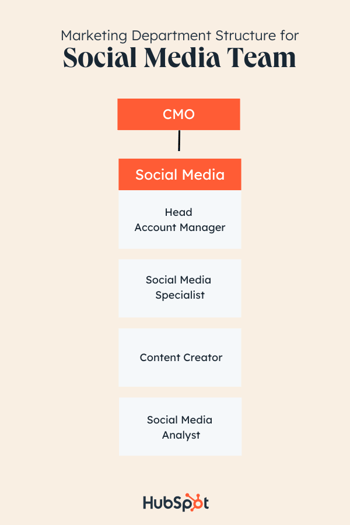
Your social media team will create and execute social media marketing efforts. This team will need to have knowledge of how to make engaging content to drive brand awareness, generate leads, and connect with audiences.
To properly perform these job functions, your social media team should have a working knowledge of creating, scheduling, and measuring the performance of social content.
Basic graphic design skills or knowledge of design tools like Canva or Adobe will be necessary for the content creation side, while social media management tools will help teams track performance, measure success, and schedule content.
Teams also need to be comfortable with customer service, as social media teams will be the ones responding to customers who engage through social media tags or posts. They will also be communicating to customers through content copy, blog posts, and comment sections, so an understanding of the company voice and ideal customer is key.
To help small teams, social media management software provides marketers with the tools they need to execute an entire social media strategy, such as the tools within HubSpot’s Marketing Hub.
Social media structure by team size:
SMBs with a team member dedicated to marketing should have a general comfortability with basic marketing practices and social media experience to build an online presence. If you can afford multiple marketing roles, start specializing in marketing functions like social media manager, which can be its own role.
Enterprise teams can structure their social media team by having specialists and managers to lead and oversee social media strategy, as well as roles for day-to-day social media activities, such as creating Instagram Stories and Posts, video editing for Facebook, and content management.
Potential roles:
- Head Account Manager
- Social Media Specialist
- Content Creator
- Social Media Analyst
Content Marketing
Skills needed: Writing, editing, organization, graphic design, project management, SEO, HTML, and storytelling
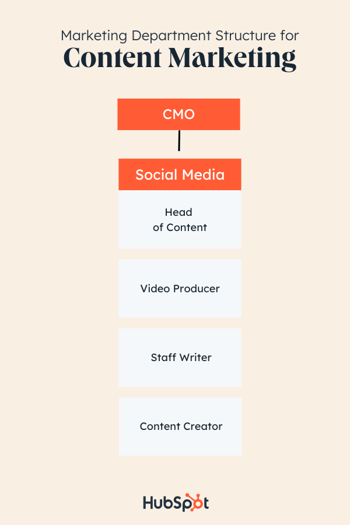
Your content creators will be the ones making sure your brand has enough content to tell a cohesive, compelling story. The content they produce will be useful in every facet of your marketing functions, from video to blog posts.
Content creators are skilled writers; they usually know how to create a solid blog post or webinar. They also have to be keen on editing — their blogs, videos, and social media content depend on it.
This team will be the go-to for the production of high-quality multimedia assets for your business, including podcasts, videos, ebooks, or other materials as needed. They may have to work on projects with other teams to make sure the messaging is correct, so your content creators should be ready to collaborate with others.
When building this team, make sure that your content creators are familiar with online management software, like HubSpot’s Marketing Hub. This makes their job easier. Instead of having to analyze data from multiple different sources, online software keeps all of that data in one place.
Content structure by team size:
In a startup, your content creation team might also be your social media and product marketing team. Though the roles are similar, content marketers need to have good organization and time-management skills in a fast-paced environment, so make sure the person you hire can work autonomously and in a team setting.
Hire a content creator who understands the story of your brand and brand voice. Their methods of sharing your voice through video, podcast, or ebooks should ultimately incentivize prospects to learn more about your business.
Larger companies hiring for a content creation team can hire by skill or by the needs of other teams. For example, Social Media Agencies need content creators for every client or group of clients.
Potential roles:
-
Head of Content
-
Video Producer
-
Staff Writer
-
Content Creator
-
Jr. Content Creator
Product
Skills needed: Research, analysis, strategic planning, cross-functionality, writing, customer service, a creative problem-solving mindset, technical knowledge, pricing strategy, and solving for the customer

This team is so important because they will communicate the features and benefits of your product to the customer. They’ll organize and drive the messages of a product and how it connects to your brand and the customer.
Product marketers identify target audiences to communicate with through product pages and ad copy. In addition, product marketers need to be star planners with keen attention to detail, as they will be planning campaigns for your products or services.
When you hire a product marketer, look for someone who demonstrates a deep understanding of overall marketing functions since, for start-ups, they might be your only marketer. They need to know how to research, analyze metrics, use that knowledge to plan future campaigns and target the customer’s needs in all of your business’s marketing materials.
In order to bring a product to life, a product marketer needs to know how to build an effective product page, and include content that will highlight that. They need to be able to present their strategies to other decision-makers and have plans for every strategy.
Product structure by team size:
The product marketer you hire as a small business owner is likely your only marketer, or the one leading marketing efforts with another team member. Hire someone with a background or demonstrated knowledge in writing, presenting marketing, and business.
Remember, the product marketer will communicate the product’s usefulness to customers, so the team member’s skills should be robust. If you are hiring for a larger team, then, you can have a little more flexibility. You can hire product marketers by product stack, so for instance, phones and personal laptops could be product stacks for a tech company.
You can structure your product marketing team by specialty, as well—a role based solely on developing copy or producing strategy, for example.
Potential roles:
- Brand Specialist
- Product Marketing Specialist
Search Engine Optimization
Skills needed: Writing, editing, problem-solving, experience with programming and technical thinking, analytics, spreadsheets, drive, and the ability to adapt

The SEO team will mainly be driving traffic to your webpages by optimizing content and ensuring your brand is aware of the keywords necessary to rank on the SERPs for topics related to your product or service. Occasionally, they’re also required to lend expertise to make business decisions. To accomplish these goals, SEO teams need to be made up of individuals with strong technical, programming, and writing skills.
Some SEO functions require writing, editing, and proofreading content to optimize it for audiences. This is where having a strong writing background will come in handy. SEO teams should be excellent problem-solvers and think about how to optimize content specifically for search engines.
These hires should be comfortable finding and implementing keywords, which will improve how high your business ranks on Google. They will also have to develop strategies for link building and develop a basic SEO protocol for the company.
In addition, SEO specialists should be fluent in analytics software to ensure they’re able to incorporate the lessons from those metrics into their overall strategy.
SEO structure by team size:
If you work for a small company, your SEO strategist might be melded with another role. If that’s the case, make sure that the SEO functions are being carried out by someone who has an understanding of analytics and optimizing content for search engines, as well as conducting thorough keyword research..
In other words, if they can’t speak Google or Bing’s language, they probably aren’t the right fit.
Comprehending analytics and optimizing content for SEO purposes will help your business rank on search engines and reach new prospects, or nurture leads until they’re ready to purchase..
For businesses that are large enough to build a team, hire for different specialties within SEO. For instance, you can hire for historical optimization, link-building management, or raising webpage traffic.
From there, you can hire project managers and team managers who are experts in the field of SEO and can offer seasoned advice to other team members, as well as manage multiple SEO projects at once.
Potential roles:
- SEO Strategist
- Senior SEO Strategist
- Historical Optimization Writer
Website
Skills needed: Programming, Creative Suite programs, interpersonal communication, Website and email design, user-experience orientation, content management software, understanding of web standards and best practices, and SEO

Of course, any business needs a website. And as your company grows, you may find the need to hire someone full-time to maintain your website. This team will be responsible for all things dot com, so you should hire a creative proficient in web design, web strategy, and optimization.
Your web design team will use their mastery of programming and web design tools to create and maintain the message your website is conveying. They will work closely with product marketing and content teams on web page execution, so the ability to collaborate across teams is essential.
They will be the point of contact for someone who runs into a problem on your website and should be able to fix any technical issues that may arise. You should trust your web design team to create a user experience that keeps customers coming back.
Website structure by team size:
The general function of a web designer is to make the web page experience seamless, optimized, and engaging for every visitor. They’ll use their expertise to deliver a delightful experience to customers who interact with your business’s web pages.
You can structure your web design by need, but if you can afford to build out an entire team, you can start hiring Senior Web Developers to bring your site up to current standards and maintain it, while Associate level hires can assist with those job duties as your design team grows.
Potential roles:
- Web Developer
- Senior Web Developer
- UX / UI Designer
- Front-end Web Developer
- Web Designer
- Visual UX Developer
- Graphic Design Specialist
Acquisition
Skills needed: Customer centricity, written and verbal communication, solution-driven mindset, and attention to detail

Though the entire marketing team should be customer-obsessed, your Acquisition team will be made up of those who live and breathe methods for delighting the customer through every step of their buyer’s journey.
Acquisition hires are the first contact with customers — they will introduce audiences to your brand. Your acquisition team will communicate to the customer as a representative and advocate for the company, and need excellent customer-facing skills and company knowledge to do so.
Another skill valued in an acquisition team is attention to detail; these teams have to be experts in how products can help customers and capitalize on little moments that can enhance the customer experience.
The biggest question for an Acquisition team to answer is, “How can we delight the customer for every stage of the buyer’s journey?” and projects should reflect that. For instance, creating compelling content offers and tracking the performance of these CTAs will be essential for teams to make impactful strategies for driving growth.
Acquisition structure by team size:
For companies whose members don’t have the resources to build a full Acquisition team, make sure the team member you designate for acquisition can effectively communicate your brand. They should know how to delight customers every step of the way.
If you’re building a team for a larger company, hire for an Acquisition team with roles that are either exclusively customer-facing or exclusively non-customer-facing. Individual hires will be able to focus their job functions based on their interaction with customers.
For example, someone in a non-customer-facing acquisition role could have duties such as developing CTAs and content offers, so writing experience and an understanding of basic graphic design practices are critical. Customer-facing roles, then, will onboard customers, source and contact them, and identify and ease pain points they might have in their journey.
Potential roles:
- Lead Acquisition Specialist
- Customer Acquisition Specialist
- Content Acquisition Manager
2. Marketing Department Structure by Function

A slightly more traditional organization structure than the product structure above, the functional department structure leans heavily on the nuts and bolts of what makes great marketing work. This structure is similar to that of a bare-bones agency. It includes the pillars of taking a campaign from ideation to completion.
The functional marketing department structure works well for small teams that have limited headcount, resources, budget, and bandwidth. A team like this may be made up of a few full-time folks, part-time people, or it could be staffed completely by contractors.
For this structure, it’s common that your marketing department won’t own a revenue number and attribution won’t be too important (non-profits, very small service-based companies). If you’re a marketer who wears many hats and needs to hire folks with a similar work ethic, try this structure.
Operations
Skills needed: workflows, automation, written and verbal communication skills, problem-solving, team-building
Your operations team is responsible for managing the technical aspects of your marketing efforts. They’ll maintain the tech stack, handle marketing automation, manage email marketing workflows, and schedule and produce webinars.
Potential roles:
- Marketing Ops Specialist
- Email Marketer
Creative
Skills needed: graphic design, written communication, video production, photography, copywriting, front-end web design
The creative team is in charge of what your clients or customers see when they come across your brand. This team will take on graphic design, copywriting, video production, and some web design.
Potential roles:
- Graphic design
- Copywriter
Project Management
Skills needed: organization, project management, agile framework, budgeting, time management, written and verbal communication
To keep everything on schedule, within budget, and within scope, the project management team will step in. The individuals in this role will typically coordinate with both operations and creativity in order to keep things moving. They’ll manage vendors, contractors, and freelancers and also work as an event planner if needed.
Potential roles:
- Project manager
- Event planner
- Vendor manager
- Procurement specialist
3. Marketing Department Structure by Product

This marketing department structure organizes marketing teams by product. You might be thinking, “But marketing doesn’t own a product?” and that is true in the literal sense of the term, but when you think of marketing as a figurative product, you can better organize people around that product’s goals.
This approach works well for enterprise teams with predictable revenue patterns that don’t need to run frequent, stand-alone marketing campaigns to generate business. If there’s a proven marketing system in place to generate demand for the business, you can leverage a product-style marketing structure to grow in new, innovative ways. Global teams may also appreciate this structure because it reduces role redundancy across regions and gives hiring managers an opportunity to recruit talent globally.
There are three typical “products” within this type of marketing structure, plus one emerging “product” that can help differentiate your business if it makes sense within your industry.
Brand Team
Skills needed: strategic thinking, written and verbal communication, creativity, copywriting, social media management, customer journey mapping, and buyer journey mapping
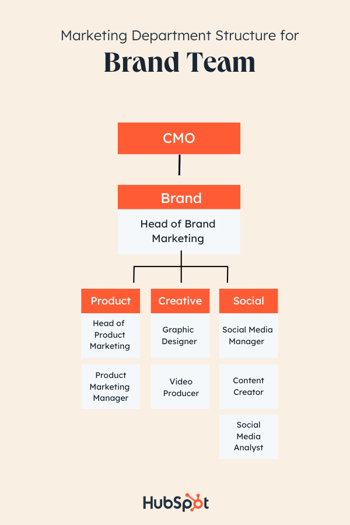
Brand includes everything about your business and distills it in such a way that potential, new, and existing customers can relate to it and external entities can appreciate it. When you’re thinking about building your marketing team around brand as a product, consider these ideas:
- Who would be responsible for the brand strategy?
- Who would be responsible for the way the brand looks, sounds, reacts, and shares ideas?
- Who would be responsible for influencing the brand in other parts of the business?
- Who would be responsible for the day-to-day championing of the brand?
Growth Team
Skills needed: Content marketing, content strategy, SEO, copywriting, web design, UI/UX design, and HTML
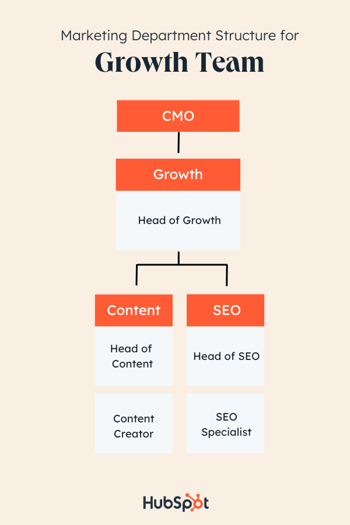
Growth marketing is responsible for generating demand and leads for the business either in existing or new markets. When you’re thinking about building your marketing team around growth as a product, consider these ideas:
- Who determines how much we grow, how fast we grow, and in which markets we grow?
- In which channels do growth opportunities exist?
- What is the short and long-term payoff of the growth strategy?
Acquisition Team
Skills needed: conversion rate optimization, UI / UX design, HTML, content development, content design, and data analysis
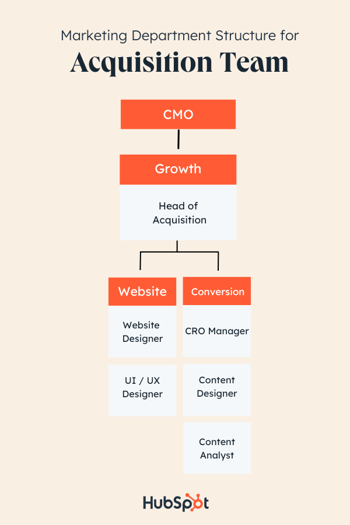
Once you’ve drawn the audience in and you’ve set growth goals, you’ll look to your acquisition “product” to secure leads and fill the pipeline for sales. When you’re thinking about building your marketing team around acquisition as a product, consider these ideas:
- Who would be responsible for the acquisition strategy?
- Who will be responsible for lead scoring and lead nurturing?
- How will the team attribute success?
Media Team
Skills needed: Video production, video editing, public speaking, creative writing, research, data analysis, and journalism
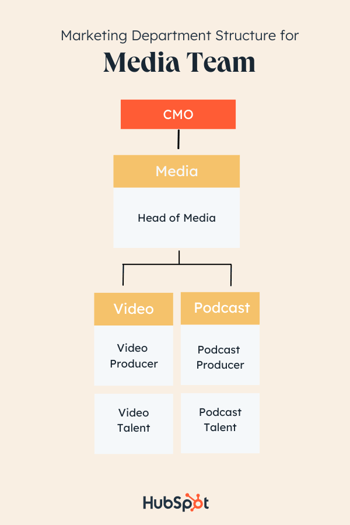
This emerging marketing “product” can and should encompass each of the three mentioned above, but it does so with an emphasis on the audience experience. Media products are best built when your brand product has a strong foothold in the market. When you’re thinking about building your marketing team around media as a product, consider these ideas:
- Is my company’s brand well-respected and sought after for thought leadership, publishing opportunities with highly-respected institutions, and generally regarded for setting the industry standard?
- Are both customers and non-customers engaging with existing marketing content from my company?
- Do the decision-makers within my industry consume media regularly enough to make this “product” worthwhile?
Types of Marketing Team Roles & Positions
Any successful marketing department structure needs a leadership and individual contributor hierarchy. How deep or wide you choose to organize your team is up to you, but here are the primary roles (in total or in part) you can expect to see in any marketing team.
Use this list to ascertain which roles you already have on your team, who in your company you can prepare for these roles, and who you should hire next.
Marketing People Leader Roles
1. Chief Marketing Officer (CMO)
Decision-making, owning the vision, and championing the team culture is the job of the CMO. This role sets the tone and standard for the entire marketing team and makes the call when the structure needs to change. The CMO reports to the CEO of the company with regard to how marketing is contributing to the business’s bottom line.
2. Vice President of Marketing
Setting the strategy for the marketing department at a high level is the responsibility of the VP. VPs may have ownership of specific products, functions, or disciplines which shapes the details of what this role looks like. They’ll have directors as direct reports and will interface regularly with skip-level reports.
3. Director of Marketing
You may see this role called a “Head of” instead of a director. The director of marketing is closely tied to their specific team which could be the entire marketing department at smaller companies or a subteam, like social media, for larger orgs. Their duties consist of putting the strategy from the VP into an actionable plan that managers can rally their teams around.
4. Marketing Manager
Marketing managers are people leaders on the front lines who manage individual contributors. Their day-to-day consists of weekly check-ins with direct reports and the director of marketing. They’re responsible for guiding their team toward meeting the goals and KPIs of the strategy.
Marketing Individual Contributor Roles
1. Marketing Consultant
A marketing consultant is typically an expert in a specific discipline like SEO or content creation. They are hired as a freelancer, contractor, or even on a part-time basis to help marketing teams reach their goals. Marketing consultants are critical to the mission of the team, but their expertise is needed in a limited capacity. If you don’t need a full-time hire on your marketing team, but would like to explore new channels, strategies, and tactics, consider bringing on a marketing consultant.
2. Principal Marketer
This individual contributor role is one of the highest-level full-time roles an individual contributor can attain in their career. These individuals are masters of their discipline rather than a jack of all trades. Internal and external team members look to them for guidance and industry-standard best practices. They may have more than a decade of experience in their discipline, but oftentimes, they have even more experience in other areas of marketing under their belt.
3. Senior Marketer
A senior marketer is one step below the principal marketer. They’re honing their skills in a specific discipline, but they may take on projects with a wider scope to build other soft and hard skills. They’re savvy with the latest trends in the marketing space and can serve as a mentor to junior members of the team.
4. Marketing Specialist
A marketing specialist plays more of a generalist role on the team. If the principal marketer is a master of one, the marketing specialist is a jack of all trades. They’re encouraged to explore a wide variety of marketing disciplines to gain an understanding of how tactics work together to achieve the strategy. From there, they’ll develop their skill set in one area of marketing that they’ll use to guide the rest of their careers.
5. Marketing Coordinator/ Marketing Associate
A marketing associate is an entry level position for recent graduates or new marketing professionals who want to change careers. They’ll take on ad-hoc assignments in various marketing departments and begin to build relationships with more senior team members. They may have an interest in one area of marketing, but they’ll work on several projects to become familiar with marketing as a whole.
6. Marketing Intern
The marketing intern is a temporary employee that is completing a degree of some kind, usually in an area of marketing or communications. They’ll explore various disciplines during their time in the company and learn how to apply the marketing lessons they learn in class to real-world situations. They may be offered a full-time position as a marketing associate or coordinator upon graduation.
How to Build a Marketing Team
1. Create a hiring strategy.
Before you can hire anyone, you need to put a strategy in place for building your marketing team.
You’ll need a clear understanding of your organization’s hierarchy. Consider how the roles within these teams overlap. For example, think about how the Acquisition and Content teams will work together.
2. Write the job descriptions.
After that, you can start to write the job descriptions and begin recruiting.
You can post jobs on your website, or on job boards like Indeed. When the applications begin rolling in, you can start to interview and vet your candidates.
It’s important that the people you hire mesh well with your team, so don’t hesitate to ask marketing friends for referrals.
Additionally, pay attention to LinkedIn connections while you’re vetting potential candidates in case you have a mutual connection. Leadership skills and the ability to fit in with your company’s culture are key here.
Plus, keep in mind that you want to hire experts. Your team should have experience and know what they’re doing.
3. Source candidates.
Before you begin recruiting candidates from external sources, look to your current team to see if anyone is interested in a marketing career. Not only does an internal candidate give you an opportunity to help someone progress their career, it saves you time and resources that you’d otherwise spend looking for external talent and getting them up to speed on your business.
If you’ve exhausted your internal talent pool or you need a more specialized skill set, there are several resources available to make this happen. Look to recruiters, headhunters, and candidate sources to help with the search. You can also browse candidate collectives or private membership groups like Black Marketers Association of America to list your job posting.
4. Extend an offer.
There’s a lot of discourse about how to interview for top marketing talent. How many interviews are too many? How do you know which candidate is the right fit? How long should the process take? We know that can be a challenge for small and large companies alike, so use this free resource to understand what you need to ask to evaluate your candidates objectively.
Once you’re ready to extend an offer, consider all the variables: their experience, their interview performance, their formal marketing training (courses, degrees, certifications), and any special skills that will help round out your team.
Use this information to craft a fair offer that aligns what they bring to the table with what the market demands. Be prepared for negotiations and questions about commonly overlooked benefits like insurance, on-call responsibilities, and professional development allowances.
5. Onboard the team.
After you’ve hired your team, you aren’t done building a great team. Building a great team continues long after the hiring process. For example, your onboarding process should help your employees understand the team culture.
Over time, building a great team is about documenting your goals, identifying gaps, and iterating on your process.
Build Your Marketing Dream Team
Hiring the best talent will require knowing the best skills for each role. Even if you’re hiring for a startup or small business and only have resources for 1-2 marketing roles at the moment, it’s still helpful to know the most transferable skills that will help you hire people who can grow into new roles in the future.
When you start with the right structure for your business type, put the right steps in place for hiring, and get the team aligned on a common vision, you’ll have a marketing team that will make even some fortune 100 companies envious.
Editor’s note: This post was originally published in November 2014 and has been updated for comprehensiveness.
MARKETING
Streamlining Processes for Increased Efficiency and Results

How can businesses succeed nowadays when technology rules? With competition getting tougher and customers changing their preferences often, it’s a challenge. But using marketing automation can help make things easier and get better results. And in the future, it’s going to be even more important for all kinds of businesses.
So, let’s discuss how businesses can leverage marketing automation to stay ahead and thrive.
Benefits of automation marketing automation to boost your efforts
First, let’s explore the benefits of marketing automation to supercharge your efforts:
Marketing automation simplifies repetitive tasks, saving time and effort.
With automated workflows, processes become more efficient, leading to better productivity. For instance, automation not only streamlines tasks like email campaigns but also optimizes website speed, ensuring a seamless user experience. A faster website not only enhances customer satisfaction but also positively impacts search engine rankings, driving more organic traffic and ultimately boosting conversions.
Automation allows for precise targeting, reaching the right audience with personalized messages.
With automated workflows, processes become more efficient, leading to better productivity. A great example of automated workflow is Pipedrive & WhatsApp Integration in which an automated welcome message pops up on their WhatsApp
within seconds once a potential customer expresses interest in your business.
Increases ROI
By optimizing campaigns and reducing manual labor, automation can significantly improve return on investment.
Leveraging automation enables businesses to scale their marketing efforts effectively, driving growth and success. Additionally, incorporating lead scoring into automated marketing processes can streamline the identification of high-potential prospects, further optimizing resource allocation and maximizing conversion rates.
Harnessing the power of marketing automation can revolutionize your marketing strategy, leading to increased efficiency, higher returns, and sustainable growth in today’s competitive market. So, why wait? Start automating your marketing efforts today and propel your business to new heights, moreover if you have just learned ways on how to create an online business
How marketing automation can simplify operations and increase efficiency
Understanding the Change
Marketing automation has evolved significantly over time, from basic email marketing campaigns to sophisticated platforms that can manage entire marketing strategies. This progress has been fueled by advances in technology, particularly artificial intelligence (AI) and machine learning, making automation smarter and more adaptable.
One of the main reasons for this shift is the vast amount of data available to marketers today. From understanding customer demographics to analyzing behavior, the sheer volume of data is staggering. Marketing automation platforms use this data to create highly personalized and targeted campaigns, allowing businesses to connect with their audience on a deeper level.
The Emergence of AI-Powered Automation
In the future, AI-powered automation will play an even bigger role in marketing strategies. AI algorithms can analyze huge amounts of data in real-time, helping marketers identify trends, predict consumer behavior, and optimize campaigns as they go. This agility and responsiveness are crucial in today’s fast-moving digital world, where opportunities come and go in the blink of an eye. For example, we’re witnessing the rise of AI-based tools from AI website builders, to AI logo generators and even more, showing that we’re competing with time and efficiency.
Combining AI-powered automation with WordPress management services streamlines marketing efforts, enabling quick adaptation to changing trends and efficient management of online presence.
Moreover, AI can take care of routine tasks like content creation, scheduling, and testing, giving marketers more time to focus on strategic activities. By automating these repetitive tasks, businesses can work more efficiently, leading to better outcomes. AI can create social media ads tailored to specific demographics and preferences, ensuring that the content resonates with the target audience. With the help of an AI ad maker tool, businesses can efficiently produce high-quality advertisements that drive engagement and conversions across various social media platforms.
Personalization on a Large Scale
Personalization has always been important in marketing, and automation is making it possible on a larger scale. By using AI and machine learning, marketers can create tailored experiences for each customer based on their preferences, behaviors, and past interactions with the brand.
This level of personalization not only boosts customer satisfaction but also increases engagement and loyalty. When consumers feel understood and valued, they are more likely to become loyal customers and brand advocates. As automation technology continues to evolve, we can expect personalization to become even more advanced, enabling businesses to forge deeper connections with their audience. As your company has tiny homes for sale California, personalized experiences will ensure each customer finds their perfect fit, fostering lasting connections.
Integration Across Channels
Another trend shaping the future of marketing automation is the integration of multiple channels into a cohesive strategy. Today’s consumers interact with brands across various touchpoints, from social media and email to websites and mobile apps. Marketing automation platforms that can seamlessly integrate these channels and deliver consistent messaging will have a competitive edge. When creating a comparison website it’s important to ensure that the platform effectively aggregates data from diverse sources and presents it in a user-friendly manner, empowering consumers to make informed decisions.
Omni-channel integration not only betters the customer experience but also provides marketers with a comprehensive view of the customer journey. By tracking interactions across channels, businesses can gain valuable insights into how consumers engage with their brand, allowing them to refine their marketing strategies for maximum impact. Lastly, integrating SEO services into omni-channel strategies boosts visibility and helps businesses better understand and engage with their customers across different platforms.
The Human Element
While automation offers many benefits, it’s crucial not to overlook the human aspect of marketing. Despite advances in AI and machine learning, there are still elements of marketing that require human creativity, empathy, and strategic thinking.
Successful marketing automation strikes a balance between technology and human expertise. By using automation to handle routine tasks and data analysis, marketers can focus on what they do best – storytelling, building relationships, and driving innovation.
Conclusion
The future of marketing automation looks promising, offering improved efficiency and results for businesses of all sizes.
As AI continues to advance and consumer expectations change, automation will play an increasingly vital role in keeping businesses competitive.
By embracing automation technologies, marketers can simplify processes, deliver more personalized experiences, and ultimately, achieve their business goals more effectively than ever before.
MARKETING
Will Google Buy HubSpot? | Content Marketing Institute

Google + HubSpot. Is it a thing?
This week, a flurry of news came down about Google’s consideration of purchasing HubSpot.
The prospect dismayed some. It delighted others.
But is it likely? Is it even possible? What would it mean for marketers? What does the consideration even mean for marketers?
Well, we asked CMI’s chief strategy advisor, Robert Rose, for his take. Watch this video or read on:
Why Alphabet may want HubSpot
Alphabet, the parent company of Google, apparently is contemplating the acquisition of inbound marketing giant HubSpot.
The potential price could be in the range of $30 billion to $40 billion. That would make Alphabet’s largest acquisition by far. The current deal holding that title happened in 2011 when it acquired Motorola Mobility for more than $12 billion. It later sold it to Lenovo for less than $3 billion.
If the HubSpot deal happens, it would not be in character with what the classic evil villain has been doing for the past 20 years.
At first glance, you might think the deal would make no sense. Why would Google want to spend three times as much as it’s ever spent to get into the inbound marketing — the CRM and marketing automation business?
At a second glance, it makes a ton of sense.
I don’t know if you’ve noticed, but I and others at CMI spend a lot of time discussing privacy, owned media, and the deprecation of the third-party cookie. I just talked about it two weeks ago. It’s really happening.
All that oxygen being sucked out of the ad tech space presents a compelling case that Alphabet should diversify from third-party data and classic surveillance-based marketing.
Yes, this potential acquisition is about data. HubSpot would give Alphabet the keys to the kingdom of 205,000 business customers — and their customers’ data that almost certainly numbers in the tens of millions. Alphabet would also gain access to the content, marketing, and sales information those customers consumed.
Conversely, the deal would provide an immediate tip of the spear for HubSpot clients to create more targeted programs in the Alphabet ecosystem and upload their data to drive even more personalized experiences on their own properties and connect them to the Google Workspace infrastructure.
When you add in the idea of Gemini, you can start to see how Google might monetize its generative AI tool beyond figuring out how to use it on ads on search results pages.
What acquisition could mean for HubSpot customers
I may be stretching here but imagine this world. As a Hubspoogle customer, you can access an interface that prioritizes your owned media data (e.g., your website, your e-commerce catalog, blog) when Google’s Gemini answers a question).
Recent reports also say Google may put up a paywall around the new premium features of its artificial intelligence-powered Search Generative Experience. Imagine this as the new gating for marketing. In other words, users can subscribe to Google’s AI for free, but Hubspoogle customers can access that data and use it to create targeted offers.
The acquisition of HubSpot would immediately make Google Workspace a more robust competitor to Microsoft 365 Office for small- and medium-sized businesses as they would receive the ADDED capability of inbound marketing.
But in the world of rented land where Google is the landlord, the government will take notice of the acquisition. But — and it’s a big but, I cannot lie (yes, I just did that). The big but is whether this acquisition dance can happen without going afoul of regulatory issues.
Some analysts say it should be no problem. Others say, “Yeah, it wouldn’t go.” Either way, would anybody touch it in an election year? That’s a whole other story.
What marketers should realize
So, what’s my takeaway?
It’s a remote chance that Google will jump on this hard, but stranger things have happened. It would be an exciting disruption in the market.
The sure bet is this. The acquisition conversation — as if you needed more data points — says getting good at owned media to attract and build audiences and using that first-party data to provide better communication and collaboration with your customers are a must.
It’s just a matter of time until Google makes a move. They might just be testing the waters now, but they will move here. But no matter what they do, if you have your customer data house in order, you’ll be primed for success.
HANDPICKED RELATED CONTENT:
Cover image by Joseph Kalinowski/Content Marketing Institute
MARKETING
5 Psychological Tactics to Write Better Emails

Welcome to Creator Columns, where we bring expert HubSpot Creator voices to the Blogs that inspire and help you grow better.
I’ve tested 100s of psychological tactics on my email subscribers. In this blog, I reveal the five tactics that actually work.
You’ll learn about the email tactic that got one marketer a job at the White House.
You’ll learn how I doubled my 5 star reviews with one email, and why one strange email from Barack Obama broke all records for donations.
5 Psychological Tactics to Write Better Emails
Imagine writing an email that’s so effective it lands you a job at the White House.
Well, that’s what happened to Maya Shankar, a PhD cognitive neuroscientist. In 2014, the Department of Veterans Affairs asked her to help increase signups in their veteran benefit scheme.
Maya had a plan. She was well aware of a cognitive bias that affects us all—the endowment effect. This bias suggests that people value items higher if they own them. So, she changed the subject line in the Veterans’ enrollment email.
Previously it read:
- Veterans, you’re eligible for the benefit program. Sign up today.
She tweaked one word, changing it to:
- Veterans, you’ve earned the benefits program. Sign up today.
This tiny tweak had a big impact. The amount of veterans enrolling in the program went up by 9%. And Maya landed a job working at the White House

Inspired by these psychological tweaks to emails, I started to run my own tests.
Alongside my podcast Nudge, I’ve run 100s of email tests on my 1,000s of newsletter subscribers.
Here are the five best tactics I’ve uncovered.
1. Show readers what they’re missing.
Nobel prize winning behavioral scientists Daniel Kahneman and Amos Tversky uncovered a principle called loss aversion.
Loss aversion means that losses feel more painful than equivalent gains. In real-world terms, losing $10 feels worse than how gaining $10 feels good. And I wondered if this simple nudge could help increase the number of my podcast listeners.
For my test, I tweaked the subject line of the email announcing an episode. The control read:
“Listen to this one”
In the loss aversion variant it read:
“Don’t miss this one”
It is very subtle loss aversion. Rather than asking someone to listen, I’m saying they shouldn’t miss out. And it worked. It increased the open rate by 13.3% and the click rate by 12.5%. Plus, it was a small change that cost me nothing at all.

2. People follow the crowd.
In general, humans like to follow the masses. When picking a dish, we’ll often opt for the most popular. When choosing a movie to watch, we tend to pick the box office hit. It’s a well-known psychological bias called social proof.
I’ve always wondered if it works for emails. So, I set up an A/B experiment with two subject lines. Both promoted my show, but one contained social proof.
The control read: New Nudge: Why Brands Should Flaunt Their Flaws
The social proof variant read: New Nudge: Why Brands Should Flaunt Their Flaws (100,000 Downloads)
I hoped that by highlighting the episode’s high number of downloads, I’d encourage more people to listen. Fortunately, it worked.
The open rate went from 22% to 28% for the social proof version, and the click rate, (the number of people actually listening to the episode), doubled.
3. Praise loyal subscribers.
The consistency principle suggests that people are likely to stick to behaviours they’ve previously taken. A retired taxi driver won’t swap his car for a bike. A hairdresser won’t change to a cheap shampoo. We like to stay consistent with our past behaviors.
I decided to test this in an email.
For my test, I attempted to encourage my subscribers to leave a review for my podcast. I sent emails to 400 subscribers who had been following the show for a year.
The control read: “Could you leave a review for Nudge?”
The consistency variant read: “You’ve been following Nudge for 12 months, could you leave a review?”
My hypothesis was simple. If I remind people that they’ve consistently supported the show they’ll be more likely to leave a review.
It worked.
The open rate on the consistency version of the email was 7% higher.
But more importantly, the click rate, (the number of people who actually left a review), was almost 2x higher for the consistency version. Merely telling people they’d been a fan for a while doubled my reviews.
4. Showcase scarcity.
We prefer scarce resources. Taylor Swift gigs sell out in seconds not just because she’s popular, but because her tickets are hard to come by.
Swifties aren’t the first to experience this. Back in 1975, three researchers proved how powerful scarcity is. For the study, the researchers occupied a cafe. On alternating weeks they’d make one small change in the cafe.
On some weeks they’d ensure the cookie jar was full.
On other weeks they’d ensure the cookie jar only contained two cookies (never more or less).
In other words, sometimes the cookies looked abundantly available. Sometimes they looked like they were almost out.
This changed behaviour. Customers who saw the two cookie jar bought 43% more cookies than those who saw the full jar.
It sounds too good to be true, so I tested it for myself.
I sent an email to 260 subscribers offering free access to my Science of Marketing course for one day only.
In the control, the subject line read: “Free access to the Science of Marketing course”
For the scarcity variant it read: “Only Today: Get free access to the Science of Marketing Course | Only one enrol per person.”
130 people received the first email, 130 received the second. And the result was almost as good as the cookie finding. The scarcity version had a 15.1% higher open rate.

5. Spark curiosity.
All of the email tips I’ve shared have only been tested on my relatively small audience. So, I thought I’d end with a tip that was tested on the masses.
Back in 2012, Barack Obama and his campaign team sent hundreds of emails to raise funds for his campaign.
Of the $690 million he raised, most came from direct email appeals. But there was one email, according to ABC news, that was far more effective than the rest. And it was an odd one.
The email that drew in the most cash, had a strange subject line. It simply said “Hey.”
The actual email asked the reader to donate, sharing all the expected reasons, but the subject line was different.
It sparked curiosity, it got people wondering, is Obama saying Hey just to me?
Readers were curious and couldn’t help but open the email. According to ABC it was “the most effective pitch of all.”
Because more people opened, it raised more money than any other email. The bias Obama used here is the curiosity gap. We’re more likely to act on something when our curiosity is piqued.

Loss aversion, social proof, consistency, scarcity and curiosity—all these nudges have helped me improve my emails. And I reckon they’ll work for you.
It’s not guaranteed of course. Many might fail. But running some simple a/b tests for your emails is cost free, so why not try it out?
This blog is part of Phill Agnew’s Marketing Cheat Sheet series where he reveals the scientifically proven tips to help you improve your marketing. To learn more, listen to his podcast Nudge, a proud member of the Hubspot Podcast Network.
-

 WORDPRESS7 days ago
WORDPRESS7 days agoTurkish startup ikas attracts $20M for its e-commerce platform designed for small businesses
-

 MARKETING6 days ago
MARKETING6 days agoRoundel Media Studio: What to Expect From Target’s New Self-Service Platform
-

 SEO6 days ago
SEO6 days agoGoogle Limits News Links In California Over Proposed ‘Link Tax’ Law
-
SEARCHENGINES6 days ago
Daily Search Forum Recap: April 12, 2024
-

 SEO5 days ago
SEO5 days ago10 Paid Search & PPC Planning Best Practices
-

 SEARCHENGINES5 days ago
SEARCHENGINES5 days agoGoogle Core Update Volatility, Helpful Content Update Gone, Dangerous Google Search Results & Google Ads Confusion
-

 SEO7 days ago
SEO7 days agoGoogle Unplugs “Notes on Search” Experiment
-

 MARKETING5 days ago
MARKETING5 days ago2 Ways to Take Back the Power in Your Business: Part 2

![How to Structure a Marketing Dream Team for Any Size Company → Click here to download our free guide to hiring and training a team of all-stars [Free Ebook].](https://articles.entireweb.com/wp-content/uploads/2023/03/How-to-Structure-a-Marketing-Dream-Team-for-Any-Size.png)













![5 Psychological Tactics to Write Better Emails → Download Now: The Beginner's Guide to Email Marketing [Free Ebook]](https://articles.entireweb.com/wp-content/uploads/2023/02/11-Free-Email-Hacks-to-Step-Up-Your-Productivity.png)


